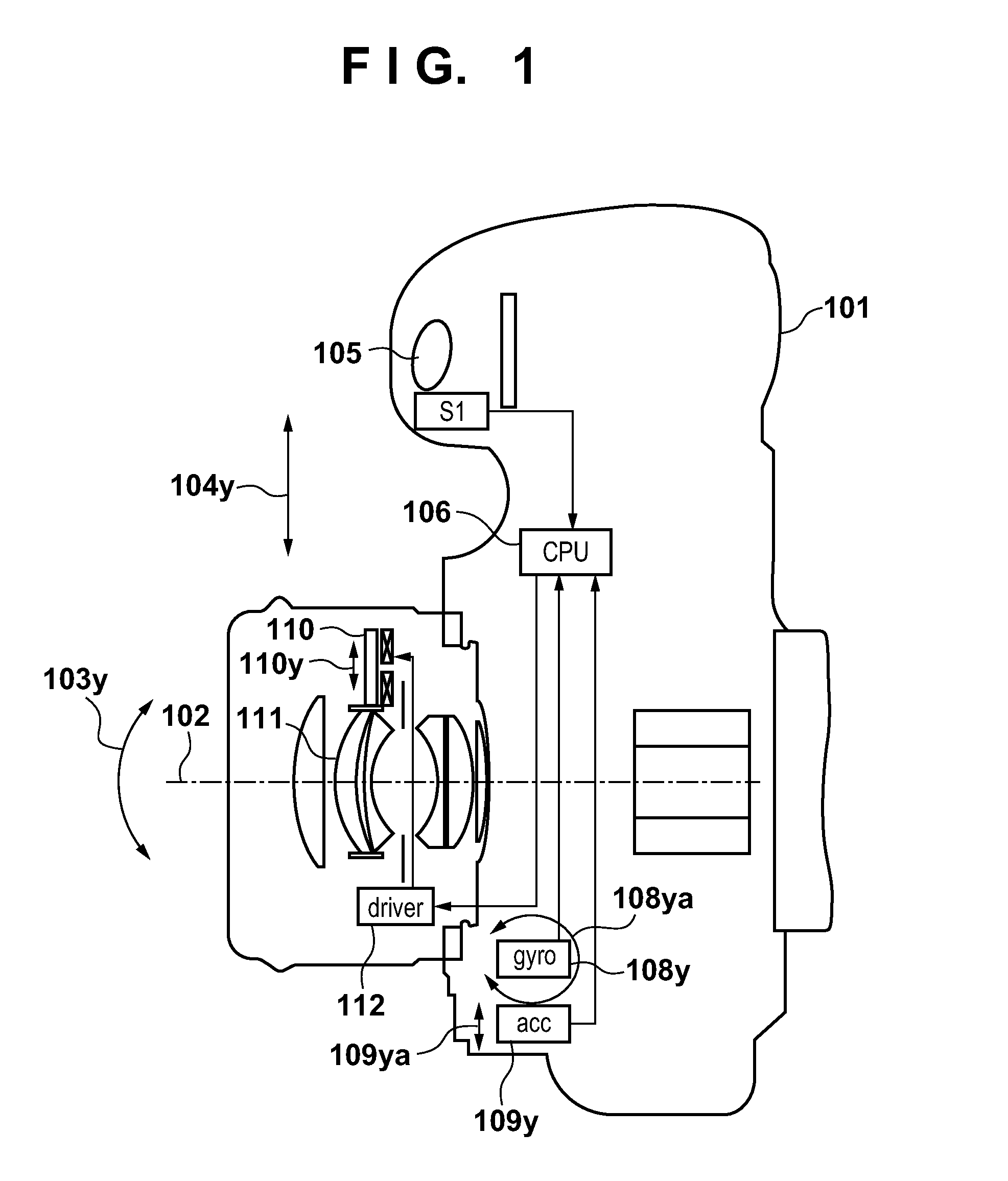Image stabilization apparatus, control method therefor, optical apparatus and imaging apparatus
- Summary
- Abstract
- Description
- Claims
- Application Information
AI Technical Summary
Benefits of technology
Problems solved by technology
Method used
Image
Examples
first embodiment
[0034]FIGS. 1 and 2 are general diagrams illustrating the functional configuration of a camera 101 embodying an image stabilization apparatus according to a first embodiment of the present invention, viewed from above and from the side, respectively. A stabilization system provided in this camera 101 compensates shakes indicated by arrows 103p and 103y relative to an optical axis 102 (called “rotational shakes” hereinafter) and shakes indicated by arrows 104p and 104y relative to the optical axis 102 (called “translational shakes” hereinafter).
[0035]The camera 101 includes a release switch 105, a camera CPU 106, an image sensor 107, and angular velocity sensors 108p and 108y that detect rotational shakes indicated by arrows 108pa and 108ya, respectively. The camera 101 further includes acceleration sensors 109p and 109y that detect translational shakes indicated by arrows 109pa and 109ya, respectively, using a different method than the angular velocity sensors 108p and 108y. The cam...
second embodiment
Variation of Second Embodiment
[0083]The second embodiment was described taking an example in which the correction gains Ka and Kb that have been set by the correction coefficient determination condition unit 314 are set in the sensitivity adjustment unit 303 and the output correction unit 311. In this variation, as shown in FIG. 11, the correction gains Ka and Kb that have been set by the correction coefficient determination condition unit 314 are set in a rotational shake correction amplifier 901 and a translational shake correction amplifier 902. In this manner, the effects similar to those of the second embodiment can be obtained.
third embodiment
[0084]A third embodiment of the present invention will be described next. The third embodiment is different from the first and second embodiments in the following points.
[0085]In the first embodiment, adjustment is performed by multiplying the translational shake correction amount by the correction gain K according to the in-focus area of the main object, and in the second embodiment, the rotational shake correction amount and the translational shake correction amount are adjusted by setting the correction gains Ka and Kb for the magnification ratio according to the in-focus area of the main object. In the third embodiment, the correction gain K is determined according to the in-focus area and magnification ratio information, rather than according to only the in-focus area.
[0086]FIG. 12 is a diagram showing a correction gain according to the in-focus area and the magnification ratio. Reference numeral 1001 indicates correction gain characteristics according to the in-focus area in t...
PUM
 Login to View More
Login to View More Abstract
Description
Claims
Application Information
 Login to View More
Login to View More - R&D
- Intellectual Property
- Life Sciences
- Materials
- Tech Scout
- Unparalleled Data Quality
- Higher Quality Content
- 60% Fewer Hallucinations
Browse by: Latest US Patents, China's latest patents, Technical Efficacy Thesaurus, Application Domain, Technology Topic, Popular Technical Reports.
© 2025 PatSnap. All rights reserved.Legal|Privacy policy|Modern Slavery Act Transparency Statement|Sitemap|About US| Contact US: help@patsnap.com



